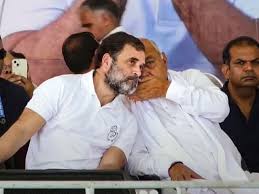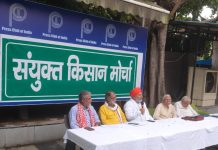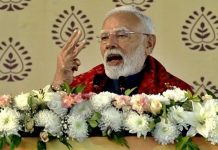It is clear that BJP can be decimated by a united Opposition. But in the case of a one-on-one contest where the Congress and the BJP are pitched against each other, the Congress could hit a roadblock by KumKum Chadha

The so-called strongman of the state of Haryana is vanquished; Congress’s Bhupinder Singh Hooda was exuding the confidence of “sweeping the polls”. However, the Congress lost the state it had pegged its hopes on. The BJP, on the other hand, regained some of its lost glory.
For record, the Lok Sabha election results were kind of a shocker because the BJP which was riding on the is baar 400 paar spiel, failed to get even a majority.
In Jammu and Kashmir, democracy has won: people came out in hordes to cast their vote clearly opting for the ballot rather than the bullet; the hollowness of the PDP’s claim of being a kingmaker is there for everyone to see. Add to this the fact that protagonists for azaadi were clearly on the backfoot.
A case in point: the banned Jamaat-e-Islami and Engineer Rashid’s Awami Ittehad Party failed. Rashid, it may be recalled, had managed a spectacular win in the recent Lok Sabha elections after trouncing former Chief Minister Omar Abdullah.
But this is less about the contest in two states and more about the big picture; this is less about who won and who lost in Haryana and Jammu and Kashmir.
This is more about the national message the electorate has delivered both in the Lok Sabha in June and the state elections in October. This is also about the lessons learnt and unlearnt and the takeaways for the political parties in the fray.
For starters, it is important to understand that the toss up is not between Prime Minister Narendra Modi and Congress scion Rahul Gandhi. If one has to choose between the two, chances are that one would opt for a seasoned politician like Modi to run the country. Rahul Gandhi may have garnered support through his Bharat Jodi yatra or even firing salvos at Prime Minister Narendra Modi, but this should not be interpreted as the acceptance of the people to handpick him to lead the country. Or govern a complex nation like India.
Equally, it is true that Modi may not be India’s best bet in the long run. But in the current scenario, he surely is its immediate answer.
Therefore, one may ask: why did the electorate not support the BJP whole heartedly in the Lok Sabha elections, and why was the mandate fractured?
The answer is clear: BJP’s failure to get a majority indicates that the electorate is willing to look for options outside the BJP. And that is exactly what it did. It mooted for the India alliance but it did not push hard enough to oust the BJP from power. Therefore, it would not be wrong to conclude that in the first round, the Indian electorate was looking for a strong Opposition which could provide the necessary checks and balances to a government which was, on several occasions, riding roughshod.
This is precisely the reason why the “save the Constitution” move worked like nothing else did. Rahul Gandhi may have carried around the Indian Constitution’s pocket edition but to see him as a symbol of that appeal would be a mistake. It was a crusade helmed by a united Opposition rather than the Congress.
Equally, it is clear that the BJP can be decimated by a strong and united Opposition. But in the case of a one-on-one contest where the Congress and the BJP are pitched against each other, the Congress could hit a roadblock, like it did in Haryana. In Jammu and Kashmir too, it was in the reckoning because it rode piggyback on the National Conference.
Having said that, one cannot negate the local factors that were at play in both the states.
As for the Congress, it vacillated between a leadership vacuum and a one man show. In Jammu and Kashmir, it did not have any mass leader to campaign; neither was it able to pull out all the stops during its campaign.
As against this, in Haryana, it committed the fatal mistake of overdependence on Hooda at the cost of others, including Kumari Selja, former Union Minister and a Dalit leader in her own right. Hooda is a Jat by caste.
Backing Hooda alienated the important Dalit vote.
The BJP on its part seized the moment and branded Congress as an “anti Dalit Party” and charged it with insulting Dalit leaders including Kumari Selja.
It is well known that Kumari Selja had not campaigned actively during the polls. To add to the Party’s woes, Union Minister and former Chief Minister Manohar Lal Khattar had asked her to cross over to the BJP.
One last word on the exit polls that went horribly wrong. Yet again.
Like the Lok Sabha elections, the state elections in Haryana and Jammu and Kashmir, prove that the exit polls are completely off the mark. During Lok Sabha elections, when all polls were talking about numbers on the premise that the majority for the BJP was a given, the saffron party won only 240 seats out of 543 seats. It had to depend on allies for government formation.
Similarly, in the two states: in Haryana, the exit polls had forecast a clear majority for the Congress and a hung assembly in Jammu and Kashmir. As against this, the BJP wrested power in Haryana and the National Conference and Congress alliance secured a decisive win in J-K.
So, what does this indicate? That the Indian voter is mature enough not to give his mind. There are visible gaps between what he says and what he does.
This was true in the Lok Sabha elections as it was in the state elections where the results were contrary to expectations. If pollsters failed to grasp the undercurrent, the voter was either silent or saying contrary to what he intended to do.
This is one part but the more important and significant message is that democracy is still alive in India despite attempts to throttle it by a handful.












